-

In December 2018, we rolled up to the start with Formula E for the first time, becoming a partner to the ABB FIA Formula E Championship during the fifth season of this fully electric street racing series. For two years, we were a Formula E partner and main sponsor of the races run in Europe—the “voestalpine European Races”.
In April 2019, a year after the groundbreaking ceremony for the world’s most advanced special steel plant, construction on the EUR 350 million voestalpine BÖHLER Edelstahl project in Kapfenberg, Styria began. From 2021, the new special steel plant is designed to produce around 205,000 tons of special steel each year for the international aerospace, oil & gas, and toolmaking industries.
In May 2019, we opened the Technikum Metallurgie (TechMet) in Leoben-Donawitz, our pioneering research facility for high-tech steel, and the only one its kind in the world. Here at the small-scale steel mill, we are conducting research into the production of new high-performance steels for subsequent processing into special rails, quality rod wire, and extremely high load-bearing OCTG by the Group's companies in Styria.
On November 11, 2019, H2FUTURE, the currently world's largest pilot plant for CO2-free production of green hydrogen in the steel industry successfully commenced operations. It is currently the world's largest pilot plant for the CO2-neutral production of hydrogen and is setting an international milestone in the advancement of new energy supply options. H2FUTURE is an EU-funded project in which partners voestalpine, VERBUND, Siemens, Austrian Power Grid, K1-MET, and TNO are researching into the industrial production of green hydrogen to replace fossil fuels in the steel production over the log term. It is one of the promising projects advanced by voestalpine to reduce CO2 emissions in steel production.
In early 2020, voestalpine Böhler Welding, a welding technology specialist and part of the Metal Engineering Division, acquired a majority stakeholding in Selco s.r.l, an established Italian manufacturer of welding machines.
As was the case in nearly all regions of the world, we were almost immediately impacted by the outbreak of the coronavirus in March 2020. The pandemic and its consequences are facing us with major economic challenges. As a result of massive reductions in capacity and production shutdowns in the automotive, aerospace, mechanical engineering, and oil & gas industries, demand in voestalpine’s key customer segments collapsed within a matter of days. Consequently, around 50 European Group companies registered for short-time work, allowing them to maintain the necessary degree of flexibility and to save jobs in the Group wherever possible. Furthermore, immediately following the emergence of the virus, the we established a task force which drew up appropriate guidelines and measures as the situation developed. By summer 2020, our economic situation had largely recovered: apart from the oil & gas and aerospace segments, order levels returned to a satisfactory level. From October 2020, a second wave of the coronavirus pandemic hit many regions of the world, and especially Europe, facing us with a fresh set of challenges.
In fall 2020, we opened the world's most advanced continuous caster at the site in Donawitz. Here the voestalpine Metal Engineering Division will produce high-grade steel for processing into special rails for railway infrastructure, premium wires for the automotive industry, and high-quality seamless tubes for oil & gas exploration.
The Supervisory Board approves preliminary work on climate-friendly steel production. In summer 2022, we began clearing the necessary construction sites and carrying out infrastructural conversion work at our two Austrian sites in Linz and in Donawitz.
As part of the "Sustainable Steelmaking" (SuSteel) research project, the use of hydrogen plasma for a carbon neutral steel production process is being investigated in a new pilot facility at the voestalpine Donawitz site.
At the Linz site, almost EUR 100 million is being invested in the expansion of the hot-dip galvanizing lines in order to meet the growing demand for high-quality high-strength steels in the future. The technological ramp-up is sceduled for 2025/26.
Around four years after the official groundbreaking ceremony in 2018, the new state-of-the-art special steel plant at the voestalpine site in Kapfenberg has been completed and was officially opened in October 2023. This marks a technological milestone for voestalpine in the production of pioneering high-performance materials for the international automotive, energy, and aerospace industries. The new plant, which plays a pioneering role worldwide in terms of digitalization and sustainability, is the first of its kind to be built in Europe in four decades.
In March 2023, the voestalpine Supervisory Board approved the construction of two green electricity-powered electric arc furnace plants in Linz and Donawitz with an order volume of EUR 1.5 billion. On September 13, we celebrated the groundbreaking ceremony for the construction of the electric arc furnace plant at the Donawitz site, and only a short time later, on October 10, 2023, the traditional groundbreaking ceremony for the construction of an electric arc furnace as part of the greentec steel project took place in Linz. These milestones mark the start of the next generation of steel production at voestalpine. The partial conversion to electric arc technology at the two sites in Linz and Donawitz alone will reduce CO2 emissions in Austria by around 5% from 2027. greentec steel will therefore be Austria's largest climate protection program at this time.
In October 2023, voestalpine has acquired the Italian warehouse and racking specialist Torri S.P.A. Nedcon, a subsidiary of the Metal Forming Division, is further strengthening its position in the demanding racking system solutions segment with this acquisition.
In May 2024, voestalpine acquires a majority stake in the Italian premium welding wire manufacturer ITALFIL S.p.A. The voestalpine Böhler Welding Group is thus expanding its product portfolio in the semi and fully automated high-quality welding technology sector.
-
voestalpine.jpg)
hydrogen pilot facility H2FUTURE, Linz In the fall of 2008, the economic slump resulting from the worldwide banking and financial crisis also affects voestalpine. To respond to the deteriorating situation, the Group’s crisis management, which is implemented rapidly and across the board, focuses on Group-wide cost optimization and efficiency improvement programs. The 2009/10 business year, which is buffeted by the major economic crisis, is the hardest and most difficult since the onset of the Group’s privatization in 1995. In the first nine months of the business year 2010/11, however, voestalpine manages yet again to generate significant increases in both revenue and earnings.
Orders for turnouts for high-speed railway lines in both Europe and Asia enable the voestalpine Group in 2008 to continue expanding its leading position in the fast-growing rail market and to become the number one in Asia for high-speed turnouts. 2009 sees the launch of a turnout production facility in France. Thanks to a joint venture with a Chinese company, the Chinese railways agency awards a project involving the delivery of high-speed turnouts for the most significant railway project in China thus far—the Beijing to Shanghai line—to voestalpine. The same year, the Group also continues to broaden its presence in the United States.
In 2009, voestalpine supports the bid of the city of Linz (the capital of Upper Austria) to be named Europe’s “Capital of Culture” (the “Linz 09” project). voestalpine Stahlwelt is officially inaugurated in the fall of the same year.
Even though the worldwide economic and financial crisis continues unabated in the business year 2009/10, in 2010 voestalpine Stahl GmbH continues to implement its EUR 700 million investment program named “L6”; “L” signifies the Linz site and “6” the increase in the crude steel capacity from about 5.4 million tons per year to 6 million tons per year. As part of this project, 2011 and subsequent years see the start-up of the wide strip mill, which has undergone both a completely modernization and a capacity expansion; the construction of a melting pot gas holder; and the installation of a new DeNOx system for the denitrification of sintering exhaust, making it the most environmentally friendly plant in Europe. The Böhler Welding Group opens an expanded facility for welding consumables in Indonesia.
A new Group structure is adopted in 2010 for the purpose of boosting efficiency yet further: the Automotive and Profilform divisions are combined in the new Metal Forming Division. The division name changes and the decision to use only English names for the divisions going forward turns the existing five divisions into four: the Steel Division (its name was merely switched from German to English); the Special Steel Division (previously the German equivalent of Special Steel Division followed by High Performance Metals Division); the Metal Engineering Division (previously the German equivalent of Railway Systems Division); and the Metal Forming Division (see above).
A consolidation phase during the crisis is followed by the substantial expansion of investment activity in the business year 2012/13. The Group launches the construction of a direct reduction plant in Texas, its largest ever foreign investment. The groundbreaking ceremony takes place in April 2014.
2012 also sees the dramatic expansion of the Group’s global automotive presence thanks to numerous new plants in China, the US, South Africa, Romania, and Germany as part of the Metal Forming Division’s comprehensive globalization strategy.
The same year, the Group presents a revolutionary enhancement of its patented phs-ultraform® technology, a hot-dip galvanized, ultra high-strength steel for auto body parts that can be shaped into its final form in a single process step. The start-up in 2016 of the world’s first phs-directform facility in the town of Schwäbisch Gmünd, Germany, constitutes a technology leap in lightweight automotive construction. Thanks to the requisite investments, the same year the Linz-based Metal Forming Division becomes the world’s largest site for the production of automotive blanks.
On September 14, 2016, voestalpine inaugurates a new research & development center for 3D printing of metal parts at its Düsseldorf, Germany, site. This “voestalpine Additive Manufacturing Center” is designed to develop the process for manufacturing particularly complex and light metal components. In the future, two High Performance Metals Division companies—Böhler Edelstahl GmbH & Co KG, Austria, and Uddeholms AB, Sweden—will be tasked with delivering the metal powder that is specially manufactured for this process.
The direct reduction plant in Corpus Christi, Texas, USA, is inaugurated on October 26, 2016. It is the world’s largest and most modern plant of its kind, as well as the largest investment to date by an Austrian company in the United States. Henceforth, it will produce two million tons annually of high-quality hot briquetted iron (HBI) as a sophisticated pre-material for the production of steel. The facility is considered an environmental benchmark and thus is an important step for voestalpine in its quest to lower the amount of CO2 in connection with steel manufacturing.
In July 2017, voestalpine AG is given a new corporate design that is intended to reflect the company’s orientation toward the future and its fundamental change from a steelmaking group to a technology group.
Its employees hold about 14.5 percent of the shares of voestalpine AG in 2017. The voestalpine Mitarbeiterbeteiligung (employee foundation for the Group's employee participation plan) is a unique construct the world over that combines the voting rights of some 24,000 employees in 84 voestalpine Group companies (status as of 2017).
voestalpine underscores its commitment to the future of its key production facilities in Austria. Among other things, this entails the start-up in September 2017 of the world’s most modern, fully digitalized wire rod mill at the Metal Engineering Division’s headquarters in Donawitz. The company announces just a few weeks later that the Kapfenberg special steel plant, partly more than 100 years old, will be replaced by a new one—the first steel production plant to be built in Europe in more than 40 years. At up to EUR 300 million, this is the High Performance Metals Division’s largest single investment to date.
Upon receiving confirmation from the state government of Upper Austria that its environmental compatibility review resulted in a positive finding, in 2018 voestalpine (as part of a consortium) launches the construction of a pilot facility at its Linz site for the production of hydrogen. This facility is slated to be the world’s largest of its kind and in the future will provide insights into the possibilities of using hydrogen in the individual stages of the steelmaking process.
In the business year 2017/18, voestalpine posts both its highest revenue and its highest earnings since being privatized in 1995.
-

Linz site In 2002, the Steel Division launches the largest investment program ever of an Austrian industrial company. The Linz 2010 program (which was initially supposed to run until 2010) entails an investment volume at the Linz site in excess of EUR two billion and enters its final phase in 2007, much earlier than planned. This expansion and modernization program encompasses new processing facilities, capacity increases, additional jobs, and a reduction in emissions—all with the aim of maintaining the company’s competitiveness in the long term and thus assuring the Linz site’s future.
At the heart of Linz 2010 is the relining and expansion of Blast Furnace A in the fall of 2004, which entails expanding the diameter of the furnace’s hearth from 10.5 meters to 12 meters. Associated facilities (including the sintering plant, the power plant, LD Steel Plant 3, the rolling mills, and the galvanizing lines) are aligned with this new production capacity. The decisions and planning related to the “L6” follow-up-project as well as the first steps to implement it also fall into this period. “L” signifies the Linz site and “6” the increase in the crude steel production capacity from roughly 5.4 million tons per annum to more than 6 million tons per annum.
In 2002, the company acquires Vossloh AG’s 45.3 percent stake in VAE. Both this acquisition and that of the remaining free-float shares (9.4 percent) turn voestalpine Bahnsysteme GmbH into the sole owner of the world’s leading manufacturer of turnouts.
voestalpine AG’s employee shareholding scheme is expanded to 6.4 percent in March 2003 and finally to about 10.5 percent of the voting rights of voestalpine AG in the fall of 2003.
In September of that year, voestalpine is fully privatized and a convertible bond for the remaining 15 percent of the stake still in government hands is issued. The bond is converted on August 31, 2005, with the result that from then on voestalpine is a public company. In addition, the “motion division“ is renamed the “Automotive Division” at the end of 2005.
In 2006, the world’s most modern rail rolling mill is started up in Donawitz. So-called “universal rolling technology” makes it possible not only to increase the flexibility of production, but also to continue expanding the site’s technology leadership in the special rails segment.
In 2007, voestalpine Grobblech GmbH (a company belonging to the Steel Division) lands the largest single order by far in its history. This order calls for the delivery of 200,000 tons of high-quality heavy plates that are turned into pipeline tubes for the most challenging section of the Nord Stream gas pipeline project that connects Russia and Germany through the Baltic Sea.
Environmental awareness and consistent environmental management substantially reduce emissions despite growing production volumes. 2007 also sees the start-up in Linz of the so-called “maximized emission reduction of sintering” (MEROS) system—at the time the world’s most modern and powerful waste gas treatment system for sintering plants. It lowers emissions arising from the sintering line by 90 percent on average. The same year, a plastic injection system goes into operation in Blast Furnace A. Fossil-based reducing agents (such as heavy oil and coke) are replaced to a considerable degree by specially prepared plastic waste in pelletized form, thus further lowering both carbon dioxide and sulfur dioxide emissions.
The Group attaches high priority to research, development, and innovation. In the fall of 2004, for example, a new research center is opened in Linz. voestalpine is one of the most research-intensive groups in the European Union. While it is ranked 175th overall in 2008, it is number one in Austria itself. The fact that voestalpine is ranked 10th worldwide among steel producers is of particular note in this connection. The Group also wins numerous environmental and safety awards.
It continues to expand its international footprint in the years leading up to 2008, for example, in Eastern Europe, India, China, Brazil, and Great Britain. In 2004, the VAE Group, for example, makes acquisitions in India, one of the fastest growing rail markets, to further strengthen its leading global position in both switches and turnout systems.
In 2008, the percentage of voestalpine shares held by employees under voestalpine’s existing employee shareholding scheme is raised to 11.3 percent.
2007 sees the voestalpine Group crossing a new threshold in terms of its size. voestalpine AG acquires the majority stake in BÖHLER-UDDEHOLM AG and operates the company as its Special Steel Division from July 1st. In the 2007/08 business year, the Group’s total workforce exceeds 41,000 employees—yet another landmark.The remaining shares of BÖHLER-UDDEHOLM AG are acquired in 2008, turning the company into a wholly owned subsidiary of voestalpine. At revenues of EUR 11.7 billion, the 2008/09 business year is the best to date in the Group’s history.
-
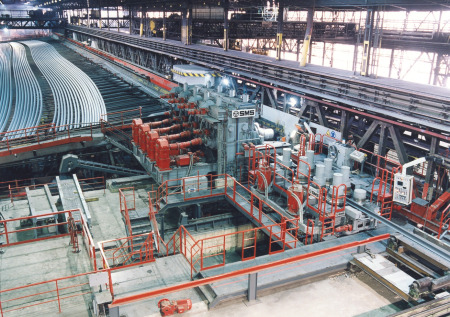
Roller leveler and rail cooling bed (120 m) in Donawitz The privatization of VOEST-ALPINE STAHL AG begins in October 1995 with the sale of 31.7 percent of the Republic of Austria’s shares on the stock exchange. BÖHLER-UDDEHOLM AG also goes public the same year.
A number of acquisitions are made in this period. In 1998, for example, the VOEST-ALPINE KREMS Group acquires METSEC plc, a British company, to buttress its already leading position in the European steel sections and precision tubes segment. In 2001, voestalpine motion gmbh acquires the Dutch automotive supplier Polynorm N.V.; it is the largest acquisition to date in the history of the voestalpine Group. The Railway Systems Division, in turn, expands its market leadership by taking over Thyssen Schienen Technik GmbH (TSTG), Duisburg, Germany. In 1998, however, the VOEST-ALPINE STAHL Group’s attempt to acquire PREUSSAG STAHL AG (Salzgitter, Germany) fails because German politicians intervene to block the transaction.
Up until 1998, the voestalpine Group continues to both enhance its product mix and expand the share of processing operations.
Investments during this period comprise the following projects and facilities among others:- At VOEST-ALPINE STAHL Linz GmbH, the casthouse dedusting system of Blast Furnace A and the new gas and steam turbines for the generation of electricity and industrial steam in the power plant are started up in 1995 and 1996, respectively. The turbines are both an economic and an environmental milestone (reduction of nitrogen oxides), because they largely ensure the company’s energy self-sufficiency.
- A project involving a facility for manufacturing laser-welded blanks (sheet steel blanks for the automotive industry) is launched in Linz; the facility goes into operation in mid-1997, after merely one year of construction—a record.
- VOEST-ALPINE SCHIENEN GmbH & CO KG in Donawitz institutes a remodeling and expansion program in 1997 to strengthen its technology leadership.
- At VOEST-ALPINE STAHL LINZ GmbH, the continuous annealing line in Cold Rolling Mill II—a European milestone in continuous annealing technology—is started up in 1998, followed by Secondary Dedusting 2 in 1999 and a new vacuum system in LD Steel Plant 3 the following year.
- voestalpine Grobblech GmbH’s product launch in 2001 of innovative sour-gas-resistant linepipe plates is an important innovation.
- A modernization campaign is launched at the Donawitz site. Among other things, it includes the conversion in 2000 of the LD steel mill into a state-of-the-art LD compact steel plant and the decision in 2001 to invest in the modernization and expansion of rail production.
The employee shareholding scheme is implemented at the Group level from November 2001. Employees at the Group’s Austrian sites hold about four percent of the company’s shares.
The corporate structure is changed in 2001: dividing the Group into four divisions—Steel, Motion (renamed Automotive later on), Railway Systems, and Profilform—serves to fully align the Group’s activities in the direction of processing (as per the slogan, “More out of Steel”). This entails not just processing and finishing steel, but also extending the value chain in crucial ways to high-tech companies and niche providers. As before, the Group’s strategy focuses on quality instead of volume increases. Finally, the Group is renamed voestalpine AG: from this point forward, it pursues an umbrella brand strategy under the voestalpine brand. -
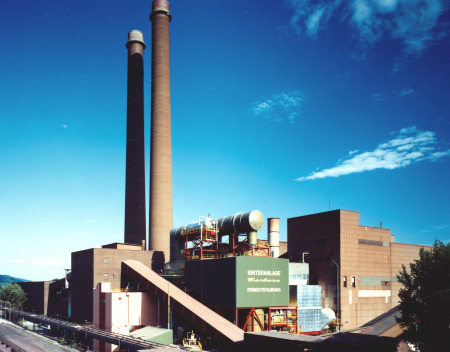
Dedusting system for Sinter Belt 5 (1993) Against the backdrop of the ongoing crisis in the steel market, in late 1993 VOEST-ALPINE STAHL AG, as the managing holding company, is divided into three divisions: flat products; long products; and with main divisional companies and subsidiaries as well as acquisitions. Processing and service sites are located in Germany, Belgium, Italy, and France. To optimize its portfolio, in 1994 the company divests itself of activities that are either unrelated to its core segments or offer too little in the way of group synergies (e.g. VOEST-ALPINE Stahl Judenburg GmbH). The next step entails concentration and specialization on high-quality niche products. A balanced customer portfolio—key customers include leading European automakers and white goods manufacturers, the construction industry, and international railway authorities—become the company’s distinguishing characteristic.
This two-year period sees the start-up at the Linz site of a new, globally unique dedusting system for Sinter Belt 5 that VOEST-ALPINE Stahl Linz GmbH developed in cooperation with VOEST-ALPINE Industrieanlagenbau GmbH as part of a two-year research project.The opening of a mechatronics laboratory at the Linz training center and the expansion of electrolytic strip galvanizing are completed. Linz-based VOEST-ALPINE Stahl develops an apprenticeship training program in cooperation with the University of Linz that leads to qualification as a “mechatronics technician.”
The company’s R&D activities are focused on the metallic processing of thin sheets and those possessing a thin organic coating (newly developed colofer® systems). Among other things, materials for structural steels used in offshore applications are also developed.
In 1994, moreover, the following major investments are approved for the years to come: the installation of a continuous annealing line, the construction of a new continuous caster in LD Steel Plant 3, work to concentrate the company’s cold rolling mill activities in Cold Rolling Mill 2 (all in Linz) as well as investments to assure the quality of rail production (in Donawitz).
The year 1995 is dominated by the transition of VOEST-ALPINE STAHL AG from a nationalized company to a public one. -
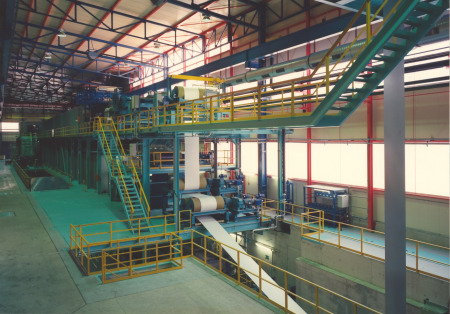
Coil Coating Plant - COLOFER Owing to the events of 1985, an entirely new corporate management is appointed in 1986. The company’s workforce is greatly reduced, both in that year and in subsequent years. The Stahlstiftung (Steel Foundation) is founded in 1987 to support those employees who have lost their jobs. This social innovation is aimed at helping them gain skills in new fields or acquire higher skills in their existing professions so that they can be reintegrated into the workforce. By 1991, the Foundation has enabled 700 employees to switch to new fields and/or to improve their qualifications.
Corporate planning is now focused on consolidation, automation, and partial restructuring. In the fall of 1986, the so-called “Concept for a New VOEST-ALPINE” is adopted after a thorough analysis of all of the company’s lines of business. A new organizational structure is developed, an automation program is adopted, and an investment program is authorized. ÖIAG provides the requisite funds. These measures are intended to restore VOEST-ALPINE’s profitability.
Österreichische Industrieholding AG (ÖIAG) is established under the 1986 ÖIAG Act. In 1988, the fundamental reorganization of the ÖIAG Group leads to the formation of six holding companies and thus to the complete overhaul of the steel sector of Austria’s nationalized industries. In 1989, these six sectoral holding companies of ÖIAG are contributed to Industrie- und Beteiligungsverwaltungs-GesmbH (IBVG), a wholly-owned subsidiary of ÖIAG, which is converted into Austrian Industries AG in 1990 and takes the first step in the direction of public ownership by issuing a going-public bond.
In 1988, VOEST-ALPINE STAHL AG, which had been created in connection with the restructuring, achieves the turnaround in almost all of its segments. It comprises six main divisional companies: VOEST-ALPINE Stahl Linz GmbH; VOEST-ALPINE Stahl Donawitz GmbH; Böhler GmbH Kapfenberg; Böhler AG Düsseldorf; VOEST-ALPINE Stahlhandel AG; and VOEST-ALPINE Rohstoffhandel GmbH. A four-pronged group structure emerges in 1989 as a result of further restructuring and concentration: flat products, long products, special steel, and trade.
From then on, the Group focuses its work on promoting high-tech products with ever-increasing degrees of finishing as well as on boosting its internationalization in two directions: West and East. A more long-term objective entails the introduction of environmentally sophisticated, yet cost-effective process technologies.
This results in the adoption in 1987 of, among other things, an ecologically-minded investment program aimed at environmental protection. The emissions data for the Linz site are made public for the first time in 1988.1989 sees the start-up of both the coil coating line (COLOFER®) in Linz and the horizontal continuous caster as part of the special steel segment located in Kapfenberg. Starting in 1990, VOEST-ALPINE SCHIENEN GmbH & CO KG sets standards in modern rail production by manufacturing ultra-long, special head-hardened rails with lengths of up to 120 meters. The turnout manufacturer VAE AG is spun off from the VOEST-ALPINE Group in 1989 and becomes one of the first entities of the state-owned industry to be privatized in subsequent years.
In 1991, VOEST-ALPINE Krems GmbH expands its profile plant by a new line for special tubes and acquires the Belgian producer of cold-rolled sections, SADEF N.V. This acquisition represents a first important step in the Group’s internationalization.
In Kapfenberg meanwhile, the finishing touches are being applied to a new multi-line rolling mill. Europe’s most advanced plate testing center opens in Linz in 1992.
VOEST-ALPINE STAHL AG succeeds in substantially improving its strategic position in 1990 by acquiring the Swedish Uddeholm Group (which is merged with the Böhler Group companies the following year to form Böhler-Uddeholm) and by deciding to reorganize the long-product segment.
The plan is to restructure, automate, and strategically realign the companies allocated to VOEST-ALPINE STAHL AG. The new organizational structure—decentralized accountability for both costs and operating profits as well as organization into business segments—which is introduced in 1991 is fully implemented in 1992.
At the end of 1993, Austrian Industries AG is split up into three separate groups under the Austrian Privatization Act: VA Technologie AG, Böhler-Uddeholm AG, and VOEST-ALPINE STAHL AG. -

Commissioning of Blast Furnace A (1977) Following the merger of VÖEST and Österreichisch-Alpine Montangesellschaft, between 1974 and 1976 a number of other companies are consolidated into new entities and newly integrated into VÖEST-ALPINE AG if necessary. Particularly important in this connection are Gebrüder Böhler & Co AG, Schoeller-Bleckmann Stahlwerke AG, and Steirische Gußstahlwerke AG—companies forming part of the nationalized special steel industry—which are consolidated into a new entity named Vereinigte Edelstahlwerke AG (VEW). VEW is the largest subsidiary of the VÖEST-ALPINE Group.
The effects of the merger of VÖEST and Österreichisch Alpine-Montangesellschaft already coincide with the first oil crisis and the large rupture in prevailing economic trends. Starting in 1975, Austria, too, is affected by the fallout from the international steel crisis, such as the general decline in prices. The steel industry is buffeted by massive changes, which trigger a steep decline in growth. In turn, this initiates rapidly accelerating structural changes in the industrialized countries’ steel industries. To lessen the impact of economic cycles on the steel sector, the management of VÖEST-ALPINE shifts its focus to the expansion of its activities in industrial plant engineering and finished goods.
In mid-1977, the Group puts in place a new organizational structure, specifically, a multi-dimensional segment structure. The Group is divided into four divisions (steelworks, processing, finished goods, and industrial plant engineering) that are each accountable for their own bottom line. As part of the reorganization, in 1978 industrial plant engineering is placed under the direct control of the Management Board. Furthermore, the name VÖEST-ALPINE AG is tweaked ever so slightly—Ö (the letter O with an umlaut) is changed to a simple O—and the company’s logo is revamped.
The company has been trying to penetrate a broader range of markets since the late 1970s. Hence a comprehensive diversification strategy is initiated in 1980. It marks a shift toward highly processed and top-quality products providing the greatest possible added value, process innovations, the company’s entry into the high-tech sector as well as an intensified focus on trade.
This strategy entails the founding in 1982 of VOEST-ALPINE Medizintechnik GmbH, VOEST-ALPINE Glas GmbH, Austria Mikrosysteme International GmbH, and VOEST-ALPINE Energieservice GmbH as subsidiaries and associates of the VOEST-ALPINE Group. The following year sees the creation of a new division named Electronics and Automation under the direct control of the Management Board; it combines all production and service activities related to electronics.
Starting in 1979, VOEST-ALPINE AG begins work on developing the so-called “COREX process” in cooperation with Korf Engineering GmbH, a German company in which it holds a 49 percent interest; this process makes it possible to generate pig iron directly from non-metallurgical coal and iron ore in inexpensive and environmentally friendly ways (“coal reduction process”). Korf Engineering GmbH is taken over in 1983 and becomes a wholly-owned subsidiary.
The following facilities among others are started up between 1975 and 1985: Cold Rolling Mill II; Blast Furnace A with a hearth diameter of 10.5 meters and a maximum pig iron output of 5,500 tons per day; the world’s largest plasma melting furnace at the electric steel plant in Linz; a continuous caster for billets and a wire mill in Donawitz; the oilfield piping plant in Kindberg; and the precision steel tubes plant in Krieglach. One of the most modern apprentice training centers in Austria is also completed in Donawitz.
The crisis that has been brewing in the nationalized industries for a long time finally comes to a head in 1985: As VOEST-ALPINE has been writing lots of red ink since 1981, the government has stepped in repeatedly to help with capital infusions, but these entail stricter state control over the allocation of the funds.
The fact that the Group has used its political clout to lasting effect; the fact that it has been abused to serve as a national labor pool; changes in international economic parameters; the erosion of individual companies; diversification failures in both foreign projects and the finished goods division (among others, the Bayou Steel Corporation in Louisiana, USA; mechanical engineering in Liezen; etc.); as well as the enormous losses that a company named Intertrading (which was founded in 1978 and is VOEST-ALPINE’s trading subsidiary) has run up in connection with its speculative activities in the oil market lead to the bankruptcy of VOEST-ALPINE in 1985 and the resignation of its entire Management Board. The conglomerate, which by then has 70,000 employees, is broken up. The “VOEST Debacle,” as it is known, literally triggers a national crisis and sets in motion a far-reaching restructuring process in Austria’s industries. -
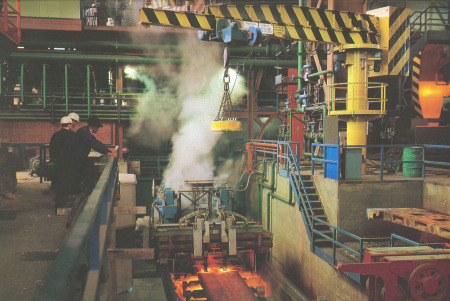
Continuous slab casting unit The 1960s see VÖEST developing into—by Austrian standards—a huge and multifaceted conglomerate with an international sales network comprising 274 business relationships in 87 countries as early as in 1968.
The First Austrian Nationalization/Organization Act of 1963 launches the corporate reorganization of VÖEST. It is aimed at counteracting the economy’s cyclical fluctuations, concentrating the highly scattered ownership structures of the state-owned industries, and enhancing the efficiency of management and coordination. In 1963, therefore, several plants that have already been closely associated with VÖEST are integrated into the company as part of its reorganization: the Krems steelworks and Wiener Brückenbau as subsidiaries, and the Liezen plant with both mechanical engineering and foundry as a production unit. The decision is made to restructure the production program of the Krems steelworks.
Among other things, a special investment program for 1965‑68 aimed at modernizing the finishing operations, automating the rolling mills, and reducing capacities in production facilities that are stretched to the limit now and then leads to the construction of a 10,000 m³ oxygen system—the first continuous slab casting unit in LD Steelworks 2—that is started up in 1968. Moreover, LD Steelworks 2 is expanded by a sixth converter, which serves not only to boost production capacity, but also to showcase the state-of-the-art plant as proof of VÖEST’s industrial plant engineering prowess.
To enable long-term corporate planning, the Management Board resolves on February 17, 1969, to put in place planning workgroups tasked with defining the goals of both the company and its business segments and preparing a long-term action plan. The resulting “Goals and Action Plan of VÖEST for the Mid-1970s” are the first steps in the direction of this kind of general planning.
Among others, a Sendzimir cluster cold rolling mill, which is built by the mechanical engineering department under license and enables the production of very thin plate; LD Steelworks III; and the galvanizing line in Cold Rolling Mill II are started up in Linz between 1970 and 1973. The new apprentice training center also opens. The addition of the cold rolling mill brings the number of VÖEST’s cold rolling mills to a total of three with an annual total capacity of 650,000 tons of sheet steel.
On June 20, 1972, Österreichische Industrieverwaltungs-Aktiengesellschaft (ÖIAG), the Austrian stock corporation tasked with managing the equity interests of the Republic of Austria, decides to merge the Linz-based operations of VÖEST and the Vienna-based operations of Österreichisch-Alpine Montangesellschaft with the aim of boosting the efficiency of the two organizations. The merger, which elicits a lot of opposition, is made retroactive to January 1, 1973, in accordance with the relevant Federal Act of February 15, 1973.VÖEST fears that the substantially weaker financial position of Alpine AG will cause it to incur losses, while Alpine AG, for its part, fears that it will be dominated by VÖEST. High-quality flat products, i.e. sheet steel and plate of all grades and dimensions, are manufactured in Linz from the steel produced locally, whereas semi-finished goods such as billets, slabs, and blanks as well as finished goods such as steel bars and sections, wire rods, hot-rolled steel strip, and rails are manufactured in Donawitz.
The aforementioned Federal Act also provides for the transfer of the equity interests of ÖIAG in Gebrüder Böhler & Co. AG and Schoeller-Bleckmann Stahlwerke AG, both Vienna, as an in-kind contribution to the new VÖEST-ALPINE AG effective January 1, 1973.
This creates a group consisting of a total of 103 companies that are majority-owned by VÖEST-ALPINE AG as the parent company either directly or by way of its subsidiaries. Add to that qualified minority interests in 14 companies. -
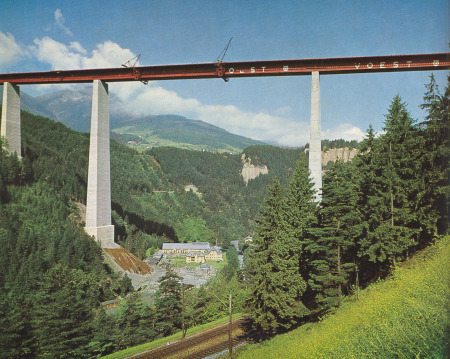
Assembly works on the steel structure of Europabrücke (1962) The second half of the 1950s sees substantial increases in production activity and sales, both nationally and internationally.
In 1956, VÖEST acquires all of the shares of Brassert Oxygen Technik AG (BOT), Zurich, Switzerland, a company responsible for licensing the LD process. This company manages the LD patents and their commercialization by granting licenses to third parties. A year later, VÖEST assigns one half of its equity interest in BOT to Oesterreichisch-Alpine Montangesellschaft, which had participated in the development of the LD process.
In 1957, VÖEST begins to build deep-sea vessels to show in practice that LD steel plates are indeed suitable for shipbuilding, but also to bring some stability to the freight costs the company incurs as a result of its substantial purchases of raw materials abroad. A total of four cargo ships named Linzertor, Wienertor, Kremsertor, and Buntentor (i.e. “gate to Linz”, “gate to Vienna,” and so forth) are launched by 1967.
In 1958, VÖEST begins to build LD steelworks in Rourkela, India—the first to be located outside of Austria—in cooperation with Fried. Krupp, Essen, Germany. This event also marks the starting point of VÖEST’s entry into international industrial plant engineering. The dedusting equipment for all of LD Steelworks 1 is finally completed the same year, after several years of intensive R&D work, testing on two of the three converters as well as a number of improvements. 1958 also sees the start-up of the 4.2 meter heavy plate line at the Linz plant, and 1959 the start-up of LD Steelworks 2.
The public management of VÖEST, which had been in effect since the end of WWII, is replaced the same year by corporate bodies pursuant to securities law. VÖEST is given a management board, a supervisory board, and an annual meeting.
In 1960, the management of Wiener Brückenbau und Eisenkonstruktions A.G. (WBB), later renamed VOEST-ALPINE Hebetechnik- und Brückenbau AG, is transferred to VÖEST.
The plant’s own harbor is inaugurated the same year as soon as the expansion has been completed. Among other things, 1962 sees the start-up of a rebuilt blast furnace that represents the state of the art. All the necessary work and planning has been carried out by VÖEST employees. A second cold rolling mill built by VÖEST itself is started up and production of clad plates begins the same year.
All investment activities are focused mainly on modernizing and automating industrial production. The 1962 annual report has this to say on the topic:
“The production capacity that has been put in place has outstripped the increase in demand. The already existing gap between production capacities and sales potentials will become even greater once the additional iron and steelworks now under construction are completed.” Given the economic law of supply and demand, it is inevitable that this will trigger heightened competition and thus a decline in iron prices. To make matters worse, the resulting large revenue losses occur in tandem with considerable cost increases, especially as regards personnel expenses. -

LD Steel Making Plant 1 US military units reach Linz on May 5, 1945. The Linz factories are seized in their capacity as “German assets” and renamed Vereinigte Österreichische Eisen- und Stahlwerke AG (VÖEST) in accordance with two orders of the US military government dated July 18, 1945, and October 1, 1945, respectively. They are also spun off from Alpine Montan AG. Public administrators are commissioned to manage the plants.
The gradual work to repair the damage and provisionally start up individual facilities begins right after the end of the war, but the fate of the Linz plants is difficult to predict at the time. Intense differences of opinion erupt with respect to the plants’ continued existence. It is even debated whether they should be torn down altogether. Protracted negotiations and interventions precede the factories’ continuation.
The decision to continue operating the Linz plants also triggers substantial changes in the region’s economic structure. Yet the actual, full-blown reconstruction and expansion of the facilities does not begin until the Commander-in-Chief of the US Forces in Austria, Mark W. Clark, transfers VÖEST in trust to the Republic of Austria on July 16, 1946. VÖEST is subsequently nationalized on July 26, 1946, pursuant to the first Austrian Nationalization Act. 1947 sees the first firing up of a blast furnace since the end of WWII.
The 1948 Iron and Steel Plan, which is prepared by the Ministry for the Protection of Assets and Economic Planning as well as the Ministry of Trade and Reconstruction, aims to coordinate the growth of the iron and steel industry and thus serves as the blueprint for the allocation of funds under the European Recovery Program (ERP), more widely known as the “Marshall Plan.” The production of commercial sheet steel is concentrated in Linz.
An expansion drive is launched the same year with the help of debt financing made available under the US Marshall Plan, which serves to help in the reconstruction of Western Europe. At the time, the US authorities are weighing whether to re-privatize VÖEST subject to the financial participation of the Allied powers. After entering into a state treaty with Austria, the three Western powers declare on April 8, 1949, that they will waive their claims to the “German assets.”
Nothing contributes more to VÖEST’s image in its early years and nothing has a greater impact on the company’s fortunes than the development of the Linz-Donawitz basic oxygen steelmaking process (the “LD process”). This innovation lays the foundation for an internationally competitive Austrian iron and steel industry. Scientists in Linz achieve the breakthrough after many years of work, both at home and abroad. The successful tests lead to the decision in December 1949 to build the world’s first LD steelworks in Linz.The (re-)construction of the Linz steelworks proceeds at a rapid pace. The slab mill goes into operation in 1951. The world’s first LD steelworks as well as the hot strip mill with a rolling line that has five rolling stands—one of the largest investments during the immediate post-WWII period—are officially started up in early January 1953. The cold rolling mill follows in October 1953. The investments of the first expansion phase are largely completed in this and the following year.
1954 sees the addition of the Liezen steelworks to VÖEST pursuant to an operational lease. Following the signing of the Austrian State Treaty in 1955, VÖEST takes over the management of the Krems steelworks, which until then had been under Soviet administration and thus not subject to Austrian control.In order to be able to provide adequate housing for its (new) workforce, in 1953 VÖEST launches a housing and resettlement program as well as a program to build apartments at its two new sites, Krems and Liezen. VÖEST’s social policies range from affordable housing, to employees’ medical care, all the way to childcare on the company’s premises.
-
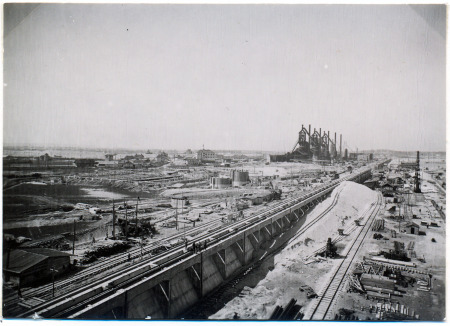
Blast Furnaces in Linz (1942) The groundbreaking ceremony for a company named “Reichswerke Aktiengesellschaft für Erzbergbau und Eisenhütten ‘Hermann Göring’” (a subsidiary of the Berlin-based German industrial conglomerate, Reichswerke AG, which had been founded in 1937) takes place on May 13, 1938, in Linz-St. Peter. The roughly 4,500 inhabitants of Linz-St. Peter/Zizlau are relocated to other parts of the city.
In March 1939, Vereinigte Stahlwerke AG (Düsseldorf, Germany) sells 56 percent of its stake in a company named Oesterreichisch-Alpine Montangesellschaft to Reichswerke Hermann Göring following strong political pressure. The same year, Reichswerke Linz is merged with Alpine Montangesellschaft into a new company called “Alpine Montan Aktiengesellschaft ‘Hermann Göring’ Linz.” In 1941, this name is changed to “Reichswerke Aktiengesellschaft Alpine Montanbetriebe ‘Hermann Göring’ Linz.”
Berliner Reichswerke owns five large companies in Linz: the headquarters of Reichswerke Alpine Montan as the parent company of all sites in Austria; Hütte Linz (Linz steelworks); Stahlbau GmbH; Eisenwerke Oberdonau GmbH; as well as the supply operations related to the Linz steelworks.
Eisenwerke Oberdonau GmbH, which was founded on April 25, 1939, launches the production of armored personnel carrier parts in 1940/41. This company is tasked with determining the volume of steel products required, and it eventually becomes the largest German factory for armored personnel carriers. The web of companies based in Linz become operational from 1941. This includes the firing up of the first two blast furnaces and the start-up of the power plant of the Linz steelworks. The war delays the initially planned expansion of the integrated iron and steelworks. Highest priority is given to the construction of Eisenwerke Oberdonau, an armaments factory. This includes building a steel mill; a sheet rolling mill; a steel foundry; a drop forge; and a heat treatment plant. The allied bombing raids on Linz and the industrial site start in the summer of 1944.
Had it not been for the foreign labor, the Linz factories would not have been built and the armaments would not have been produced, because the labor required for this work was not available in the domestic labor markets (Austria and Germany). This was due, for one, to the sheer size of the intertwined companies, whose labor requirements far surpassed the available labor pool and, for another, to the pronounced lack of workers as a result of the war.
The first civil foreign laborers arrive in Linz in the summer of 1938 to start the construction work. Later on (from 1940/41) forced laborers and prisoners of war are used as well as (from 1942) male concentration camp inmates. The concentration camp inmates are interned in two external camps of the Mauthausen-Gusen concentration camp complex that had been erected on the factory grounds and are deployed as forced labor in the Linz steelworks as well as in Eisenwerke Oberdonau GmbH and Stahlbau GmbH. Special rules on the treatment and provisioning of prisoners aimed at discriminating against them by nationality based on the racist policies of Nazi ideology underscore the forced nature of the so-called “deployment of labor” since 1940. Even though the recruitment of forced laborers does not enter its acute phase until this period, clear signs of systematic repression in the factories had already made itself felt as early as in 1939.
The number of workers in the Linz factories reaches its apex in 1944. Foreign nationals (excluding prisoners of war and concentration camp inmates) account for about two-thirds of the workforce; in some operations they even account for more than 90 percent (e.g. in the forge). Slightly more than ten percent of the foreign laborers at the Linz site are women.
Our history
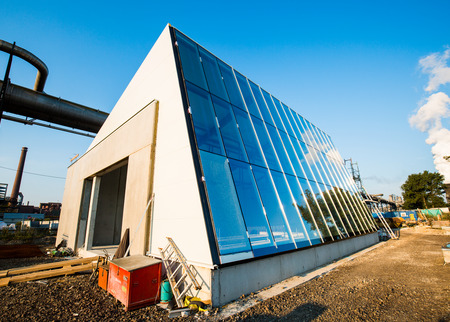
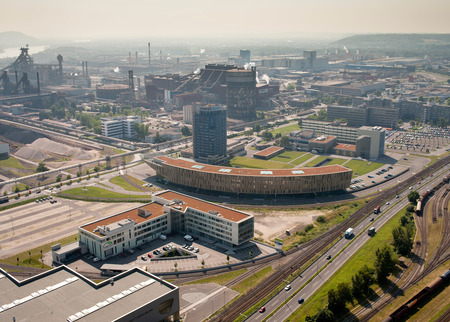


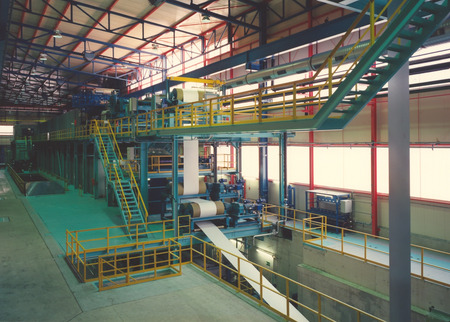
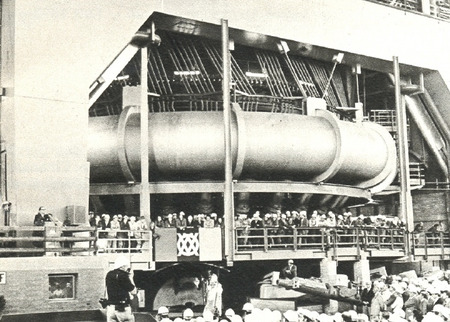
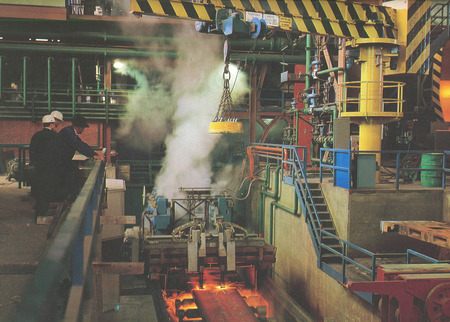

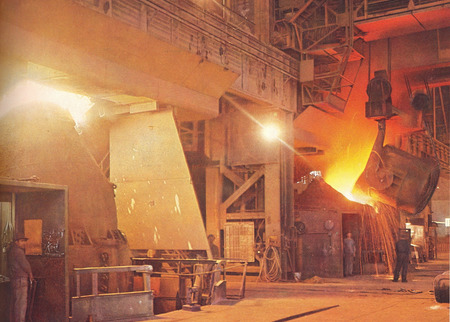

We have played an important role in the economic history of both Linz and Austria for over 80 years. Our long history begins with the erection of the “Hermann Göring” works, includes the Group’s privatization in 1995, and its current process of internationalization. Today we are a leading global steel and technology group. We are committed to the global climate goals and lead the way in developing decarbonization technologies and sustainably reducing our CO2 emissions. The historic milestones clearly highlight our impressive development.